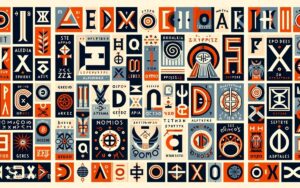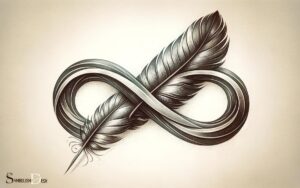What Do Symbols on Gravestones Mean? Achievements!
Symbols on gravestones, also known as cemetery symbols or gravestone symbols, represent the deceased’s beliefs, achievements, or personality traits.
They can also serve as messages to those who visit the gravesite.
Gravestone symbols have been used for centuries as a form of communication to convey various aspects about the life of the departed.
They can range from religious symbols, occupational symbols, to nature-related symbols, each having its own specific meaning and significance.
It’s important to remember that interpretations of symbols can vary significantly based on cultural, religious, and individual beliefs.
Therefore, while investigating gravestone symbols, one should consider the context in which the symbol is being used.
A comprehensive understanding of these symbols forms part of cemetery art and also helps in genealogical research.
12 Symbols on Gravestones and Their Meanings
| Symbol | Meaning |
|---|---|
| Cross | Christian faith, spirituality |
| Star of David | Jewish faith |
| Crescent and Star | Islamic faith |
| Eternal flame | Immortality, spirit |
| Dove | Peace, Holy Spirit |
| Broken column | Early death, loss, grief |
| Butterfly | Resurrection, life after death |
| Lamb | Innocence, children’s graves |
| Hand pointing up | Pathway to heaven |
| Tree stump | Life cut short |
| Hourglass | Passing time, shortness of life |
| Anchor | Hope, steadfastness |
Key Takeaway

Five Facts About Symbols on Gravestones
What Do Symbols On Gravestones Mean?
The Significance Of Symbols On Gravestones
Gravestones are markers of remembrance for loved ones who have passed away, but they also serve as reminders of our shared human history.
Symbolism on gravestones is like an alphabet of images, each with a unique meaning. Understanding the symbolism on gravestones can reveal an individual’s beliefs, lifestyle, and social standing during their lifetime.
Here are some key points about the significance of symbols on gravestones:
- Symbols on gravestones are usually influenced by cultural, religious, or traditional beliefs that the deceased held during their lifetime.
- Symbols on gravestones can also reflect the cultural, social, and historical context of the time, providing insights into broader beliefs and values shared by the community.
- Symbols on gravestones can help identify significant events or achievements in the deceased’s life, such as military service, membership in fraternal organizations, and accomplishments in their professional or personal life.
Understandings Of Gravestone Symbols
The meanings of gravestone symbols can vary from one culture to another, and even within a culture, there can be different interpretations of the same symbol.
Here are some examples of gravestone symbols and their possible meanings:
- Angels: Symbolize spirituality, guardianship, and protection.
- Doves: Represent peace, innocence, and the holy spirit.
- Hourglass: Signifies the impermanence of life and the shortness of time.
- Cross: Represents faith and christianity, with different orientations of the cross symbolize various religious denominations.
- Tree: Symbolizes life, growth, and regeneration, often used to represent families who have deep roots.
Historical Context Of Gravestone Symbols
The use of gravestone symbols has changed over time, reflecting cultural, social, and historical shifts.
Here are some key points about the historical context of gravestone symbols:
- In the 17th and 18th centuries, gravestone symbols were influenced by european styles, with an emphasis on skulls and crossbones reflecting the puritan belief in mortality and salvation.
- During the victorian era, gravestone symbols shifted towards more romantic and sentimental imagery such as flowers, angels, and clasped hands, reflecting a move towards a more sentimental and emotional approach to death.
- In the 20th century, gravestone symbols became more personalized, reflecting individual tastes and interests, such as specialized symbols denoting hobbies, interests, or activities in which the deceased participated.
Gravestone symbols represent much more than just a name and date on a stone. They provide insights into our shared human history, reflect cultural, religious, and traditional beliefs, and reveal individual beliefs, lifestyles, and social standing.
Understanding the significance of these symbols can help us appreciate the rich history and diverse experiences of our forebears.
Common Gravestone Symbols And Their Meanings
Gravestones often feature symbols that help to convey the life and beliefs of the person buried there. These symbols can be universal, specific to cultures or religions, or reflective of the profession the person held.
Understanding these symbols can provide valuable insights into the person’s life and even their personality.
Universal Symbols
- Heart: A heart symbol on a gravestone often represents love and devotion. However, it can also signify courage, spirit, or mortality.
- Cross: A cross is a symbol of christianity and represents faith, hope, and redemption.
- Dove: A dove is often used to symbolize peace, innocence, and purity.
- Flowers: Different types of flowers symbolize different emotions. For instance, lilies represent resurrection and purity, while roses represent love and grief.
Symbols Specific To Cultures
- Celtic knot: This symbol is prevalent in irish culture and represents the cycle of life and death.
- Star of david: A six-pointed star, the star of david is a symbol of judaism and represents the jewish faith and people.
- Ankh: An ancient egyptian symbol, the ankh stands for life, eternity, and wisdom.
Symbols Of Profession
- Doctor’s symbol: The doctor’s symbol features a snake coiled around a rod. It represents knowledge, wisdom, and healing.
- Carpenter’s symbol: A carpenter’s symbol features a compass and a square, representing precision and exactness.
- Musician’s symbol: A musician’s symbol consists of two eighth notes connected by a staff, representing the love of music and the pursuit of harmony.
Gravestone symbols are a beautiful way to express the life and beliefs of the person buried there.
By understanding these symbols, we can learn valuable insights into their personality and legacy.
The Evolution Of Gravestone Symbolism
In many cultures, the symbols on gravestones convey specific meanings and reveal information about the deceased.
Understanding the evolution of these symbols can offer valuable insights into the history and traditions of different societies. Understanding the evolution of these symbols can offer valuable insights into the history and traditions of different societies. For instance, analyzing the role of symbols in Devil in Ohio can shed light on how certain imagery and motifs are used to evoke mystery, fear, or cultural significance in storytelling. This highlights the way symbols transcend mere artistic expression, acting as powerful tools for communication and deeper narrative resonance.
Changes In Gravestone Symbolism Over Time
Over time, the symbols used on gravestones have evolved, reflecting changing tastes, beliefs, and cultural practices.
Some shifts in gravestone symbolisms are:
- The earliest graves relied on natural markers like rocks or trees.
- As societies became more sophisticated, people began to use carved or engraved gravestones to mark burial sites.
- In the mid-19th century, the use of symbols like angels, flowers, and crosses became popular.
- By the turn of the 20th century, more personalized gravestones featuring portraits of the deceased or their interests started appearing.
- Today, some gravestones feature qr codes that link to online memorials.
Impact Of Religion, Culture, And Traditions On The Evolution Of The Symbols
Religion, culture, and traditions play a significant role in shaping the symbols that appear on gravestones.
Some key points to note are:
- Christian symbols like crosses, angels, and doves often appear on christian burial sites, while islamic gravestones often feature calligraphy and geometric shapes.
- In some cultures, white lilies symbolize peace and purity, while in others, they are associated with death and mourning.
- In latin american cultures, the day of the dead celebration often involves using colorful decorations and intricate designs on gravestones to honor the deceased.
The Contrast Between Traditional And Contemporary Gravestone Symbols
While traditional symbols like crosses, angels, and flowers still feature on many gravestones, contemporary symbols are also becoming more popular.
Here are some examples:
- Some gravestones now feature qr codes that link to online memorials, providing information on the deceased’s life story, photos, and testimonials.
- Custom-made gravestones can now feature personalized designs, shapes, and materials like glass or steel.
- Some contemporary gravestones incorporate gps technology, allowing relatives to locate the burial site using a smartphone app.
As we can see, the symbols on gravestones have evolved significantly over time, influenced by religion, culture, and technology. These changes provide insights into how different societies view death and mourning.
FAQ About What Do Symbols On Gravestones Mean
What Are The Common Symbols Found On Gravestones?
Some common symbols found on gravestones include angels, crosses, doves, flowers, and hearts.
Why Are There Different Types Of Crosses On Gravestones?
Different types of crosses on gravestones represent different religious affiliations and denominations.
What Do Various Shapes Of Gravestones Signify?
Various shapes of gravestones have different meanings; for example, a rounded top signifies heaven, and an obelisk signifies eternal life.
What Do Different Colors Of Gravestones Represent?
Different colors of gravestones symbolize different things; for example, red symbolizes love and passion, and black symbolizes mourning and loss.
What Is The Significance Of A Broken Column On A Gravestone?
A broken column on a gravestone represents a life cut short and often signifies the death of the head of a family.
Conclusion
Symbols on gravestones have been an integral part of commemoration for centuries. They serve as a reminder of the life and times of a person.
However, due to numerous reasons, not all symbols are easily recognizable, which is why the information shared in this blog post is so crucial.
Through this article, we have learned about the meaning behind several types of symbols, each carrying a unique message.
From the anchor symbolizing hope to the ever-popular angel symbolizing protection, every symbol has a message to convey.
We have also seen how meanings can vary depending on time and culture, making each symbol’s significance multi-dimensional.
Hence, these symbols are not only relevant in the past but continue to inspire and evoke curiosity in the modern world.
By understanding the symbolism on gravestones, we pay respect to the departed while preserving a piece of history.






